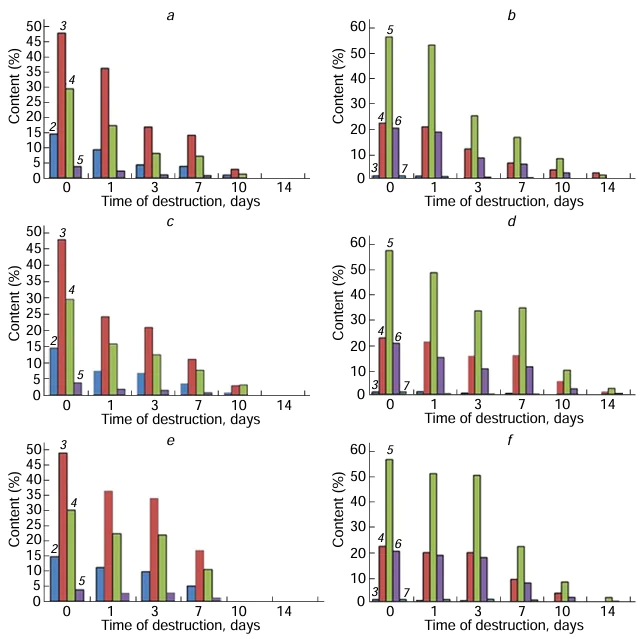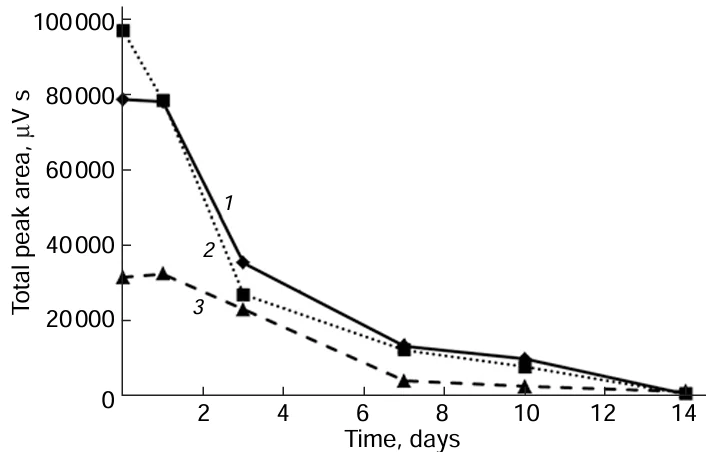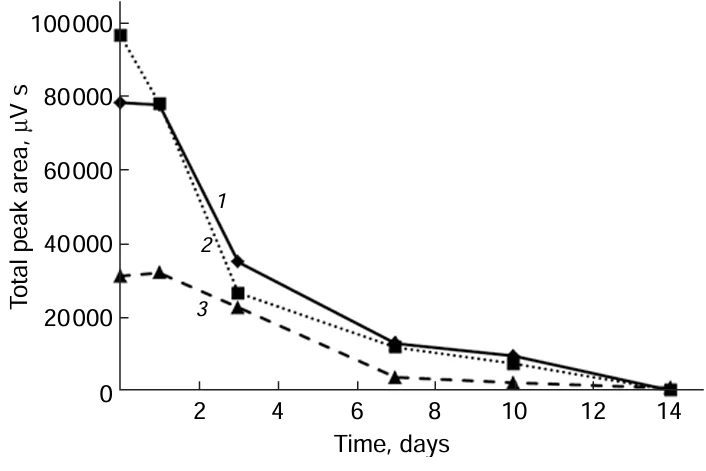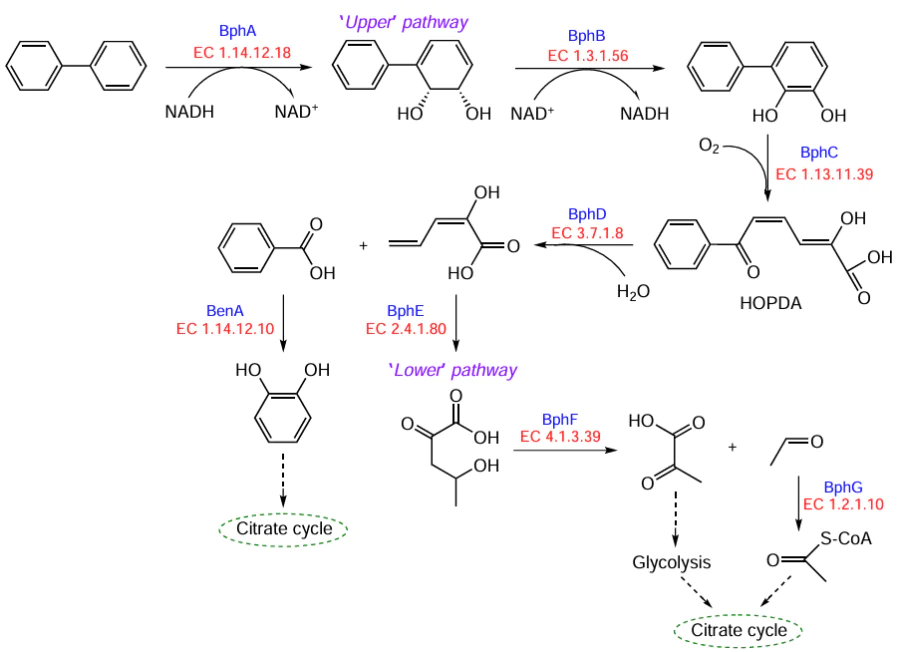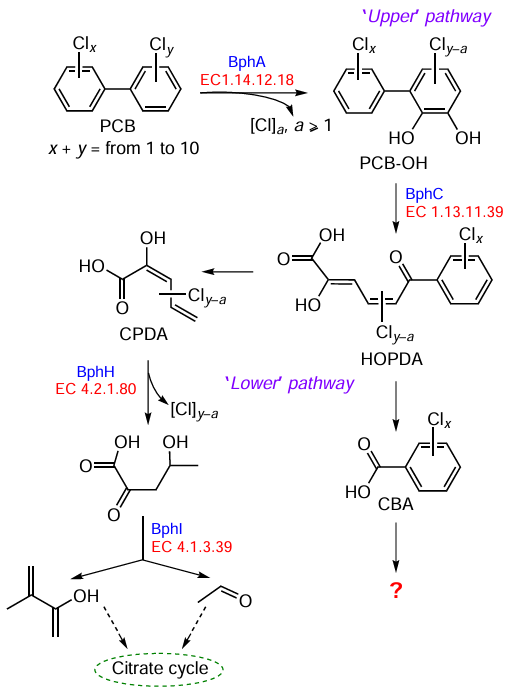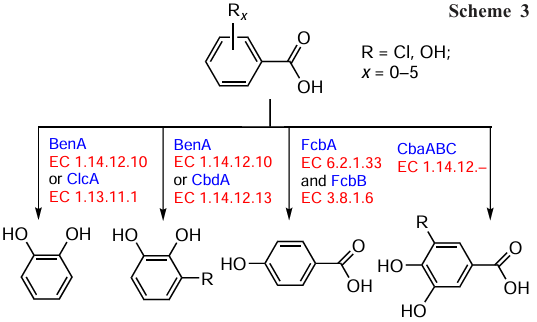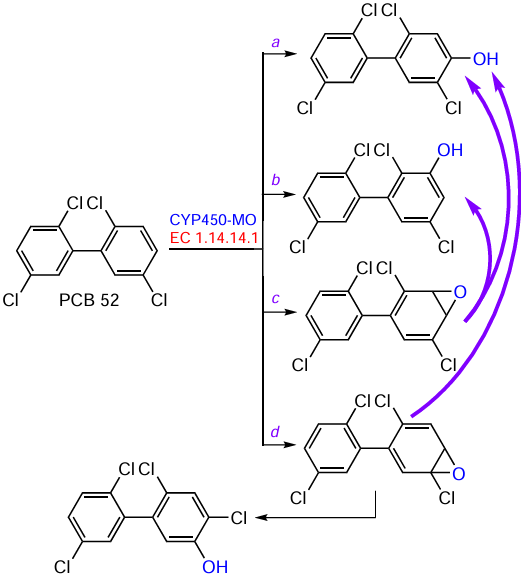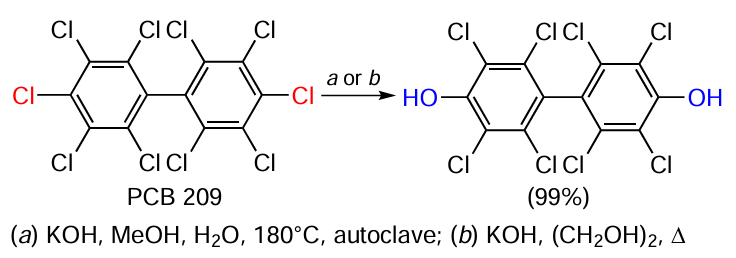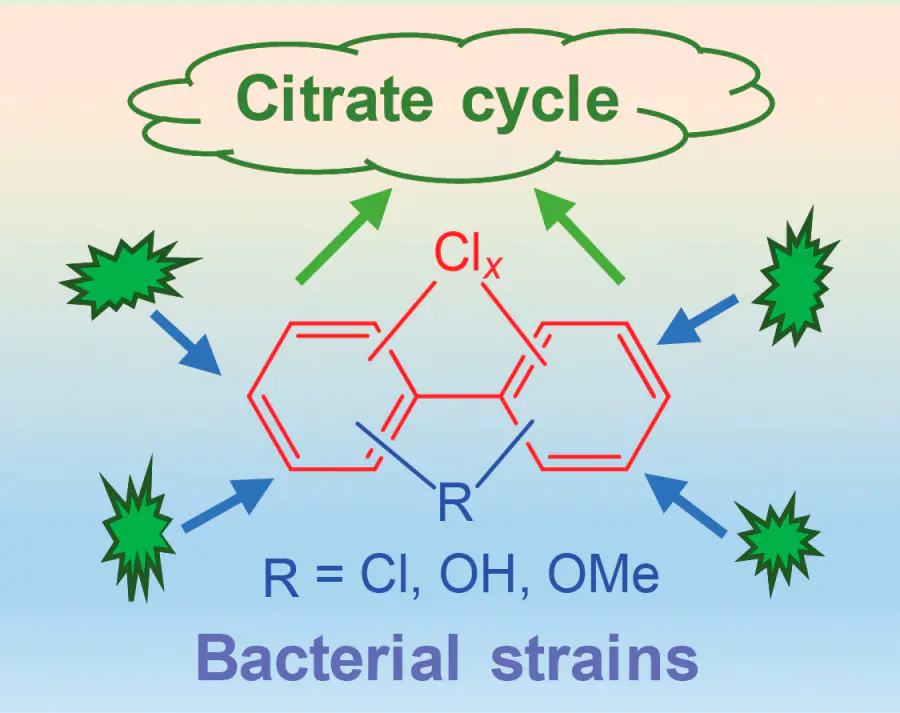Keywords
Abstract
Polychlorinated biphenyls are persistent organic pollutants hazardous to humans and to the environment. The products of biotransformation of these compounds can exist in natural objects as hydroxy and methoxy derivatives. This review summarizes the biodegradation pathways of polychlorinated biphenyls under the action of aerobic bacterial strains. The possibility of complete biodegradation of polychlorinated biphenyls and their derivatives under laboratory conditions is demonstrated. This information is valuable for researchers specializing in the biotransformations and toxicity of polychloroarene derivatives and would be useful for the development of remediation processes of natural objects contaminated with polychlorinated biphenyls. The bibliography includes 253 references.
1. Introduction
The adverse signs of the global climate change on the Earth are accompanied by permanent fluctuations in the environmental conditions and are brought to attention as increasing frequency of natural disasters. A certain contribution to this process is made by technology disasters and political and economic crises. The arising disorganization results in a slowdown or lack of progress in many international humanitarian programs and studies related to the improvement of the Earth's ecological climate, including a number of multilateral international conventions.[1-6]
Among the most harmful consequences of the global climate change is the unpredictable and uncontrollable migration of anthropogenic pollutants in natural objects (water, air, soil, bottom sediments), which increases the total contaminated area and leads to penetration of hazardous materials into previously inaccessible areas.[7, 8] In this connection, particular concern is brought about by the persistent organic pollutants (POPs), which have been recognized to be hazardous for humans and existing biotas.[9-19]
The original list of POPs, which was established by the Stockholm Convention in 2001 and called the ‘dirty dozen’, included twelve groups of compounds.[20, 21] The primary position in the list of POPs is still occupied by polychlorinated biphenyls (polychlorobiphenyls; PCBs) as a result of their large-scale production caused by high electrotechnical characteristics. According to the main requirements of the Stockholm Convention, the PCB production is prohibited; they should be eliminated from use and destroyed up to 2028. The Russian Federation ratified the Stockholm Convention in 2011 in accordance with the Federal Law No. 164 – FZ dated June 27, 2011.
The world output of PCBs is more than 1 000 000 tons,[22] of which approximately 354 000 tons entered the environment in 1930 – 1970, in particular 27 000 tons were released into air, 54 000 tons got into water, and 270 000 tons ended in dumps and landfills.[23] Due to global climate changes and transboundary transport by water, air, and food chains, xenobiotic contamination levels of natural matrices constantly vary, and their monitoring confirms the penetration of PCBs into areas without any production facilities.[7, 8, 24-26] According to reviews,[20, 24, 27] the main bulk of PCBs that have entered the environment is currently concentrated in water bodies, that is, in water, bottom sediments, and aquatic organisms. In addition, the pollution of water bodies is additionally enhanced by various types of microplastic, which enters the environment in an uncontrolled manner and has high adsorption characteristics towards POPs and, hence, it can function as a xenobiotic transporter.[1, 6, 28-32]
Over the 20th century, the average global temperature has increased by 0.6 ± 0.2°C; by the end of the 21st century, this value may amount to 1.8−4.0°C.[8] Usually, the temperature change, together with abundant precipitation and high turbulence of air leads to accelerated decomposition of anthropogenic pollutants and detoxification.[33] However, as far as PCBs are concerned, these logical patterns are irrelevant. This is related to the physicochemical properties of PCBs, which determine the persistent nature of these POPs. The PCB properties such as hydrophobicity,[34-37] long half-lives of a few decades,[27, 38, 39] thermal and chemical inertness,[22, 40-43] and optical absorption maximum in the UV region [44-48] account for long-term contamination of the environment with these xenobiotics.
Relatively recently, simultaneous detection of polychloroarenes of the PCB type and their hydroxylated (PCB-OH) and methoxylated (PCB-OMe) derivatives in the dry residue collected from sewage treatment plants in China was reported for the first time.[49, 50] Laboratory experiments showed that aerobic bacterial strains residing in wastewater sludge first produce these two types of derivatives from PCBs and then they are reversibly interconverted under the action of the same bacteria.
The formation of new PCB derivatives under the action of microorganisms is a standard and expected process,[51, 52] but detection of PCB-OH and PCB-OMe in natural matrices [49, 50] gives rise to concern about the long-term consequences of environmental pollution by polychloroarenes, considering both toxicity of the starting POPs and the products of their biotransformations.
The toxicity characteristics of polychloroarene POPs are currently calculated in terms of the most toxic compound among this group, namely, 2,3,7,8-tetrachlorodibenzo-p-dioxin, for which the toxic equivalency factor (TEF) established by the World Health Organization (WHO) was taken to be unity.[14, 53-55] For example, TEF is 0.0001 for 3,4,3',4'-tetrachlorobiphenyl; 0.0003 for 3,4,5,4'-tetrachlorobiphenyl; 0.1 for 3,4,5,3',4'-pentachlorobiphenyl; and 0.03 for 3,4,5,3',4',5'-hexachlorobiphenyl.[56, 57] The second important characteristic of POP toxicity is the toxic equivalent (TEQ), defined as TEF of a particular compound multiplied by its concentration in the test material.[56] If several POPs are detected simultaneously in the same material, then the TEQs calculated for each compound are summed up and the resulting value is the total toxic equivalent for a biotic or abiotic matrix. While analyzing definitions of TEF and TEQ, one can state that the closer the TEF value to unity, the more toxic the compound and the higher TEQ, the higher the contamination level of the specimen.
The toxicity of PCB type polychloroarenes is markedly affected by the structure of particular compounds. The planar PCB molecules, called dioxin-like, are considered to be especially hazadous.[15, 55, 58-60] The derivatives PCB-OH, which have been found as primary metabolites of PCB biodegradation,[49, 50] are also unsafe; in some cases, they are more toxic than parent PCBs.[9, 17, 61-65] For example, 4-chloro-4'-hydroxybiphenyl initiates hepatocarcinogenesis in rats;[9] mono- and dihydroxy derivatives based on tetra-, penta-, hexa-, and heptachlorobiphenyls cause endocrine disorders and abnormal expression of metabolic enzymes in humans and rats;[17] 4-hydroxy- and 3,4-dihydroxy-4'-chlorobiphenyls disrupt the reproductive processes and cause enhanced ageing of the follicles in pigs,[61] and most of the 100 investigated monohydroxylated PCBs behave as human estrogen receptor agonists and/or antagonists.[64] The toxicity of PCB-OH against bacterial strains can be manifested either as their inability to initiate the biodegradation of PCB derivatives or as the absence of growth or even the death of the colony, despite the addition of growth co-substrate.[65]
The group of polychlorinated arenes called polychlorinated biphenyls includes 209 compounds differing in the number of chlorine atoms and the arrangement of chlorine atoms in the biphenyl skeleton.[66] Data on the toxicity of these compounds in the scientific literature are constantly being updated. The PCB-OH group with only one HO substituent includes 839 representatives,[67] and there is the same number of monomethoxylated analogues. Note that the toxicity of PCB derivatives has not been studied in sufficient detail.
In view of the universal occurrence of PCBs in the environment, it is currently necessary to take prompt measures on an international scale to control the polychlorinated arene migration and penetration into living organisms.[68] These measures should be aimed, first of all, at the development of techniques for remediation of natural sites. A special position among these techniques is occupied by biological methods based on the results of processes that occur under natural conditions and in natural media. The bacterial strains that have formed in biotas may become a tool to effectively clean the natural matrices from PCB contaminants.[51, 52, 69-71] Thorough testing of the efficacy of bacterial strains in laboratory will make it possible to develop biological products for subsequent bioaugmentation.
The primary laboratory testing of microorganisms is performed using appropriate substrates and is repeated many times. Here, availability of compounds that are found in natural systems is a key problem. This problem can be addressed by using classic organic reactions to obtain compounds necessary for testing, in particular PCB-OH and PCB-OMe, which were detected in the wastewater sludge.[49, 50]
Since PCBs enter the environment in the form of commercial mixtures consisting of several dozens of compounds with different degrees of chlorination, the purpose of this review is to discuss the biotransformations of these polychlorinated arenes and their derivatives under the action of aerobic bacterial strains, as well as to provide similar data for a number of single polychlorinated arenes as model compounds.
This information is important for predicting the PCB behaviour in natural matrices and elucidation of the strategy and tactics for bioremediation POP-contaminated sites. This would lead to improvement of the health of people living today in PCB-contaminated regions; upgrading of the methods for treating water, soil, and bottom sediments to remove organochlorine compounds, expansion of safe agricultural lands, and interruption of the parts of food chains responsible for the transport of polychlorinated arenes and their derivatives into living organisms. Since the enzyme systems of bacteria and humans are fundamentally different, biodegradation of PCBs by the human microbiome is not considered in this review. Currently, no survey papers on this chemico-microbiological subject are available, and the published reviews [52, 72-74] present only data on the biodegradation of PCB congeners and their mixtures.
2. Biodegradation of polychlorinated biphenyls and their derivatives
The chemical class of PCBs includes both homologues and isomers, which are for convenience called congeners. Each congener was assigned a number (1 to 209) depending on the number of chlorine atoms and their positions according to the IUPAC nomenclature.[66] The numbering of carbon atoms in biphenyl for correct assignment of substituent locants is shown in Fig. 1.
In this review, for clarity, for any mentioned PCB congener, first, the number is given, and then the chlorine atom locants are listed in parentheses. The products of bacterial and chemical transformations of PCBs and their derivatives are not numbered in the text: many of them are mentioned once and named according to IUPAC rules, while commercial products are indicated by their trade names. In addition, the compositions of multicomponent mixtures of synthesized compounds are summarized in the corresponding Tables; since they are not repeatedly mentioned in the text, they do not have standard numbering for the convenience of comprehension.
2.1. Classical biodegradation pathways of polychlorinated biphenyls
It is known that low-chlorinated PCB congeners (mono-, di-, trichlorobiphenyls) are oxidized with the same enzymes of aerobic bacteria as unsubstituted biphenyl.[75] The biphenyl skeleton is the structural unit of many compounds occurring in the environment. They are present in crude oil, natural gas,[76] and coal tar.[77] Therefore, the pathways of biphenyl biodegradation induced by aerobic bacteria have long been studied and have been reported in considerable detail.[78-81]
It was shown that biphenyl decomposition starts with dioxygenation of one aromatic ring catalyzed by the biphenyl-2,3-dioxygenase (BphA) enzyme (Scheme 1, red colour indicates the international Enzyme Commission number).[52, 78-81] The reaction involves a reduced nicotinamide adenine dinucleotide (NADH) molecule and an oxygen molecule. The redox reaction results in the formation of cis-2,3-dihydroxy-2,3-dihydrobiphenyl. Then 2,3-dihydroxybiphenyl is formed under the action of biphenyl-2,3-dehydrogenase (BphB) and the oxidized NAD+ molecule. The oxidation of 2,3-dihydroxybiphenyl with an oxygen molecule under the action of 2,3-dihydroxybiphenyl-1,2-dioxygenase (BphC) involves C(1) – C(2) bond cleavage and thus gives 2-hydroxy-6-oxo-6-phenylhexa-2,4-dienoic acid (HOPDA). The subsequent hydrolysis of HOPDA catalyzed by a hydrolase enzyme (BphD) is accompanied by C(5) – C(6) bond cleavage and affords benzoic acid and 2-hydroxypenta-2,4-dienoic acid. This sequence of reactions representing a part of biphenyl biodegradation is called the ‘biphenyl upper pathway’.
The subsequent transformation of the 2-hydroxypenta-2,4-dienoic acid is induced by enzymes of the biphenyl lower pathway. Three successive reactions catalyzed by 2-keto-4-pentenoate hydratase (BphE), aldehyde dehydrogenase (BphF), and 4-hydroxy-2-oxovalerate aldolase (BphG) give acetyl coenzyme A (CoA), which is then used by the bacterial cell in a key metabolic process, that is, citrate cycle.
Since the first step of biphenyl dioxygenation catalyzed by the BphA enzyme is selective and involves strictly only positions 2 and 3, Scheme 1 cannot be extended to biodegradation of all PCB congeners, because for many of them positions 2, 3 or 2', 3' are occupied by chlorine.[66] However, as indicated by experimental data, PCB congeners in which positions 2, 3, 2', and 3' are occupied (partly or completely) are successfully bio-utilized by aerobic strains; this finding gave rise to two hypotheses regarding the oxidation pathways of polychloroarenes, which were subsequently confirmed.[75] According to the current views, the first step of BphA-catalyzed biodegradation of PCB congeners without substituents in positions 3, 4 or 3', 4' is dioxygenation of particularly these unsubstituted carbon atoms. One more explanation of successful biodegradation of PCB congeners with ‘inconvenient’ chlorine atom is the absence of blocking of the BphA enzyme with o-chlorine atoms. However, in this case, the PCB biodegradation pathway under the action of aerobic bacterial strains would also look differently.
The main bacterial degradation pathways of PCB congeners with unsubstituted positions 2, 3 or 2', 3' are shown in Scheme 2.[72, 78, 82-90] The degradation of PCBs, like that of biphenyl, starts with BphA-catalyzed dioxygenation of one aromatic ring. In this case, the dioxygenation is accompanied by spontaneous ejection of a chlorine atom (or atoms) from the substrate. This pathway was confirmed in a study of 1,2,4,5-tetrachlorobenzene dioxygenation in the presence of Pseudomonas bacterial strains, resulting in the formation of 3,4,6-trichlorocatechol due to the spontaneous removal of the chlorine atom from the intermediate unstable tetrachlorodiol.[75] Then 2,3-dihydroxypolychlorobiphenyl shown in Scheme 2 is converted to polychlorinated HOPDA under the action of the BphC enzyme; this product decomposes to polychlorinated benzoic (CBA) and 2-hydroxypenta-2,4-dienoic (CPDA) acids. Generally, the upper pathways for the biodegradation of biphenyl and PCB congeners coincide, while the lower pathways somewhat differ. It is considered to be proven that the conversion of CPDA under the action of several enzymes ends in the citrate cycle, while CBA transformation pathways are still a matter of debate among microbiologists.
It was ascertained [88, 91-93] that the biodegradation of chloro- and hydroxybenzoic acids by aerobic strains is performed by additional enzyme systems and gives a broad range of compounds (Scheme 3). Catechol and p-hydroxybenzoic acid and their derivatives can be formed as secondary metabolites and were detected by HPLC, GC/MS, and UV spectroscopy.
It was shown [90, 94-103] that polychlorinated HOPDA formed upon the biodegradation of PCBs, PCB-OH, or their mixtures (biphenyl upper pathway) are readily converted to hydroxybenzoic acids and also in CBA and catechols. In addition, there are examples of effective PCB and PCB-OH biodegradation without accumulation of CBA by means of Achromobacter xylosoxidans strain IR08, Burkholderia sp. strain SK-3, Cupriavidus (Alcaligenes) sp. strain SK-4, Rhodococcus ruber strain P25, and R. wratislaviensis strain KT112-7.[104-109]
Generally, studies of the bacterial degradation on going from low-chlorinated PCB congeners to medium- and high-chlorinated PCBs face a number of challenges related to identification of primary and secondary metabolites. This is due to both the structure of substrates and the features of bacterial enzyme systems that catalyze the biodegradation of polychloroarenes. There are still many questions concerning the biodegradation pathways of highly chlorinated PCBs and the identification of the enzymes involved in this processes. For example, in PCB 209, all biphenyl positions (2, 3, 4, 5, 6, 2', 3', 4', 5', 6') are occupied by chlorine atoms and it is obvious that the initial BphA-catalyzed dioxygenation of one aromatic ring in this compound is impossible (see Scheme 2). Hence, this congener should remain unchanged under aerobic bacterial degradation conditions. However, PCB 209 in 400 μg L–1 concentration degrades by 94.5% within 140 h in the presence of Comamonas testosteroni strain QL.[110]
The efficiency of biodegradation of PCB congeners largely depends on the structure of the catalytic site in the BphA α-subunit, which is a polypeptide sequence responsible for the specificity of enzyme binding to polychloroarene.[111, 112] In relation to the B. xenovorans strain LB400, which actively degrades PCBs, it was shown that threonine at positions 237, 238, and 235, tyrosine at position 277, phenylalanine at position 336, asparagine at positions 338 and 377, and isoleucine at position 341 in the BphA α-subunit cause the BphA interaction with a broad range of PCB congeners and favour a high degree of degradation of these compounds.[99, 113] The replacement of serine at position 283 of the α-subunit of BphA in the B. xenovorans strain LB400 by methionine results in a 2.5 – 4.5-fold increase in the degradation rate of polychlorinated substrates.[112] The specific interaction of BphA with PCB 15 (4,4'-dichlorobiphenyl) occurs if positions 227, 336, 337, 339, 378, and 340 are occupied by phenylalanine, isoleucine, asparagine, isoleucine, phenylalanine, and arginine, respectively.[114]
PCB 3 (4-chlorobiphenyl) is degraded at a higher rate by the R. ruber strain P25 [108] than by B. xenovorans strain LB400.[113] A comparison of the amino acid sequences of BphA α-subunits of these strains demonstrated that the amino acids at positions 226, 227, 230, 231, 233, and 239, responsible for interaction with the substrate, coincide, whereas those at positions 321, 323, 379, and 384, responsible for binding to the PCB congener, are different.[94]
Analysis of the tertiary structures of the BphA α-subunits in R. wratislaviensis strain KT112-7 (below referred to as KT112-7), R. wratislaviensis strain CH628 (CH628), and R. ruber strain P25 (P25) revealed considerable structural differences.[96] Meanwhile, the efficiency of degradation of Trichlorobiphenyl,[115] a commercial mixture of PCB congeners (produced in the USSR), was 100% for all three strains, while for the Sovol commercial mixture [116] (produced in the USSR), this value varied from 86.2 to 96.1%. It is likely that the identified differences in the BphA structure influence the reactions with highly chlorinated PCB congeners, which compose the major part of the Sovol mixture, whereas Trichlorobiphenyl consists of only low- and moderately chlorinated biphenyls.
Table 1 gives examples of using the degrading potential of aerobic bacterial strains towards PCB congeners and their mixtures. In this Table, PCBs are arranged in the order of increasing complexity from low- to moderately and then to highly chlorinated derivatives, while data on the multicomponent commercial mixtures are given at the end of the Table.
It can be seen from the data of Table 1 that Achromobacter, Burkholderia, Pseudomonas, Rhodococcus, and Sphingomonas bacterial strains are most promising for the use in biodegradation of low-chlorinated PCBs; they provide exhaustive substrate degradation within a relatively short period of time (up to 4 days) (see Table 1, lines 1, 3, 4, 6, 7, and 11). As regards moderately and highly chlorinated PCB congeners, the highest potential is inherent in the Sinorhizobium meliloti strain NM and Comamonas testosteroni strain QL (see Table 1, lines 16 and 19), which provide > 90% biodegradation efficiency of polychloroarenes. In the case of biodegradation of commercial PCB mixtures, the top position is held by Rhodococcus strains KT112-7, CH628, and P25 (see Table 1, line 28), isolated from polychlorinated arene-contaminated soils in various climatic zones of Russia.
Rhodococcus strains deserve particular attention, since a number of products manufactured in Russia for the treatment of oil-contaminated soils and waters contain these microorganisms.[137-144] Previously, it was shown that the strain P25 isolated from soil in the town of Serpukhov (Moscow Region) can degrade a broad range of chlorinated aromatic compounds, including low-chlorinated PCBs;[108, 145] the strain CH628 (Chapaevsk, Saratov Region) provides degradation of hexachlorocyclohexane and 1,1,1-trichloro-2,2-bis(4-chlorophenyl)ethane (DDT),[146, 147] and the strain KT112-7 (Berezniki, Perm Territory) demonstrated the ability to decompose chlorinated aromatic compounds, including PCBs, under various salinity conditions.[109, 148] Subsequently, the PCB-degrading potential of Rhodococcus strains was used for laboratory studies of the biodegradation of Trichlorobiphenyl and Sovol commercial mixtures (see Table 1, line 28).[95] The degradation of the group of congeners that constitute the PCB mixtures was found to have a number of specific features (Fig. 2).
Analysis of Fig. 2 indicates that the highest rate of biodegradation of the Trichlorobiphenyl mixture is inherent in the strain CH628: no PCBs were detected after 10 days. Under the action of the strains KT112-7 and P25, complete biodegradation of the congeners in the same mixture took place within 14 days. The exhaustive biodegradation of the Sovol mixture did not take place after 14 days for any of the strains, which is evidently attributable to the higher content of highly chlorinated congeners (tetra-, penta-, hexa-, and heptachlorobiphenyls) in this commercial product [116] compared to Trichlorobiphenyl.[115]
In general, Rhodococcus bacteria have high biodegrading potential against various PCB congeners, including highly chlorinated ones; therefore, these bacteria occupy top positions for the development of effective bioproducts for remediation of natural objects contaminated with PCBs.
2.2. Non-classical biodegradation of polychlorinated biphenyls
It was found relatively recently that, apart from biphenyl dioxygenases, enzymes of the monooxygenase superfamily, that is, cytochrome P450 monooxygenases (CYP450 MO), may be involved in the primary oxidation of PCBs.[149-152] However, the enzymatic activity of CYP450 MO towards PCB congeners has not been studied in sufficient detail.
Unsubstituted biphenyl and PCBs interact with CYP450 MO enzymes in essentially the same way. In relation to Rhodococcus sp. strain P14, Yang et al.[152] showed that CYP450 MO oxidizes biphenyl to 4-hydroxy derivative. Further transformations of monohydroxylated biphenyls in the presence of aerobic bacteria are accomplished in the presence of monooxygenase enzymes, in particular 2-hydroxybiphenyl-3-monooxygenase; this gives dihydroxybiphenyl, a major product of the classical upper pathway of transformation of non-chlorinated biphenyl.[153-155]
The oxidation of PCBs induced by bacterial monooxygenases is described in more detail for PCB 52 (2,5,2',5'-tetrachlorobiphenyl) [150] and PCB 118 (2,4,5,3',4'-pentachlorobiphenyl).[125, 149, 151] For example, the biodegradation of PCB 52 afforded a mixture of three primary metabolites corresponding to the class of tetrachlorinated biphenylols. The putative pathways (a – d ) towards these products are depicted in Scheme 4.
The enzymatic attack of CYP450 MO on the unsubstituted position 4 or 3 in a mineral medium results in the formation of 4- or 3-hydroxy-2,5,2',5'-tetrachlorobiphenyl (pathways a and b, respectively). Additional ways for the conversion of PCB 52 with this biocatalyst include the likely epoxidation of the C(3) – C(4) bond (pathway c) or C(4) – C(5) bond (pathway d) with the loss of aromaticity of one ring. The subsequent regioselective epoxide ring cleavage in the compound formed via pathway c may give both 3- and 4-hydroxy-2,5,2',5'-tetrachlorobiphenyls. A similar transformation of the product resulting from pathway d affords 4-hydroxy-2,5,2',5'-tetrachloro- and 5-hydroxy-2,4,2',5'-tetrachlorobiphenyls. It is worth noting that the steps of epoxide ring conversion (pathways c and d ) are non-enzymatic reactions the mechanism of which is unknown.[156]
Similar intermediates were identified in the biodegradation of PCB 118 with Bacillus megaterium strain BM3 monooxygenase (Scheme 5) *.[149]
The diversity of the formed metabolites as monohydroxylated PCBs is caused by the structure of CYP450 MO and possible changes in its conformation upon the reaction with polychloroarenes.[151] In addition, participation of this enzyme in the degradation of PCBs implies substrate specificity. Whereas the operation of dioxygenase enzymes (BphA) requires at least two vicinal unsubstituted carbon atoms in the biphenyl nucleus of the substrate, in the case of CYP450 MO, one unsubstituted carbon atom is sufficient. The potential efficiency of biodegradation of highly chlorinated PCBs in the presence of CYP450 MO is higher than that for BphA (see Scheme 2). Presumably, the biodegradation of PCB 153 (2,4,5,2',4',5'- hexachlorobiphenyl) and PCB 180 (2,3,4,5,2',4',5'-hepta- chlorobiphenyl) present in the Sovol mixture [116] with the strain KT112-7 involves particularly CYP450 MO.[95] The further transformation of the primary metabolites PCB-OH with a single HO group is not reported in the literature.
Thus, non-classical oxidation of PCB congeners by bacterial CYP450 MO results in monohydroxy(polychloro)biphenyls, which enter and accumulate in the environment and which are currently considered as secondary pollutants. Compounds the toxicity of which exceeds that of the initial PCBs have already been identified among these products. These data are based on studies of PCB metabolic pathways in living organisms and the effects of metabolic products on particular human and animal organs and their functions.[9, 17, 102, 150, 156, 157, 61-65] Note that the quantitative toxicity characteristics have not been established for PCB-OH, unlike PCBs, because these values depend on the number of chlorine atoms and HO groups in the biphenyl molecule and on the arrangement of these groups in the aromatic rings,[157] while the amount of available data on the toxicity of PCB-OH derivatives is insufficient.
* The thickness of the reaction arrows in the scheme shows the monooxygenase activity level; the compound in the solid frame is an identified metabolite, while compounds in the dashed frame are hypothesized metabolites.
2.3. Biotransformations of hydroxylated polychlorinated biphenyls
According to Scheme 2, derivatives PCB-OH are the primary metabolites of PCB biodegradation. It is likely that the pathways of the bacterial degradation of PCB-OH, formed from PCB under the action of oxygenases, should coincide with the subsequent steps of biodegradation of the parent congeners. Some specific features of PCB-OH biodegradation can be established by using appropriate model compounds. Mizukami-Murata et al.[102] investigated the bacterial degradation of a group of PCB-OH containing one HO group in position 4 induced by the Sphingomonas sp. strain N-9. Among monochlorinated PCB-OH, the highest bioconversion (100% in 3 days) was found for 3-chloro-4-hydroxybiphenyl, while its isomers containing chlorine atoms in positions 4' and 2 underwent only 23 and 33% bioutilization, respectively, over the same period of time. As the degree of chlorination increased, the biodegradation of PCB-OH was retarded, except for 3,5-dichloro-4-hydroxybiphenyl, for which this value was 100%. According to the ultra-high-performance liquid chromatography — mass spectrometry (UHPLC-MC), after incubation of this compound, 3,5-dichloro-4-hydroxybenzoic acid (m/z = 205) was present as a metabolite, which corresponds to the transformation shown in Scheme 2. In the case of 4-hydroxy-3,2',4',6'-tetrachlorobiphenyl, 3,2',4',6'-tetrachlorobiphenyldiol (m/z = 321) was detected as a metabolite; one of the HO groups in this product is located in position 4, while the position of the other one is unknown. It is evident that the enzymatic potential of the Sphingomonas sp. strain N-9 is sufficient for the degradation of 3,5-dichloro-4-hydroxybiphenyl by the upper pathway to be completed within 3 days and for the lower pathway to start. Meanwhile, in the case of more chlorinated 4-hydroxy-3,2',4',6'-tetrachlorobiphenyl, only the biphenyl upper pathway is implemented. No metabolites were found for other compounds.
In the modelling of the bacterial degradation of PCB derivatives in laboratory, the presence of all possible substrates is of particular importance; however, this cannot be provided by manufacturers of chemicals. Researchers often have to synthesize the required compounds themselves.
Nucleophilic substitution (SNAr) is a popular tool for the synthesis of the desired derivatives PCB-OH from the corresponding chlorinated derivatives. The significance of the SNAr mechanism is due to the decrease in the number of chlorine atoms in these reactions, which results in increasing hydrophilicity of the products and, hence, increasing accessibility for bacterial strains, which operate most often in aqueous media. The conduction of SNAr reactions in the series of PCBs is limited by temperatures up to 200°C, because the side formation of more toxic polychlorodibenzofurans and polychlorodibenzodioxins is possible under the reaction conditions.[158]
The synthesis of PCB-OH by the SNAr mechanism is faced with a number of problems, since even for low-chlorinated PCBs this reaction is non-selective.[159] An increase in the number of chlorine atoms in the biphenyl molecules creates conditions for the formation of multicomponent product mixtures along a variety of pathways,[160] while the absence of standard samples for identification of final products precludes exact determination of substituent positions in the molecules. The same problems arise in the quantitative analysis of the resulting mixtures: in the absence of standard samples, it is necessary to calculate, first, the total area of chromatographic peaks of the products and then the contribution of each peak to the total area. Evidently, this procedure is associated with unreliable quantitative estimates.[161]
However, single examples of selective formation of derivatives PCB-OH by the SNAr mechanism have been reported. A review [162] describes a procedure for the synthesis of 4,4'-dihydroxyoctachlorobiphenyl from PCB 209 (2,3,4,5,6,2',3',4',5',6'-decachlorobiphenyl) under fairly drastic conditions (Scheme 6).
All other syntheses of PCB-OH by the SNAr mechanism give mixtures of products. For example, the reactions of some PCBs with KOH on refluxing in 2-aminoethanol (2-AE) afford PCB-OH mixtures for 100% conversion of polychloroarenes (Scheme 7).[163, 164] Table 4 summarizes the quantitative data on the results of these reactions.
It can be seen from the data of Table 4 that in the case of PCB 12 (3,4-dichlorobiphenyl), PCB 70 (2,5,3',4'-tetrachlorobiphenyl), PCB 76 (3,4,5,2'-tetrachlorobiphenyl), and the congener mixture indicated in line 2, the number of substituents in the reaction products does not correspond to that expected for a standard SNAr reaction. For example, PCB 12 reacts with KOH in 2-AE to give chloro(hydroxy)biphenyl as two isomers by the SNAr mechanism and chlorobiphenyl also as two isomers by a different mechanism. Formally, competing nucleophilic substitution and hydrodechlorination reactions may occur in parallel under the indicated conditions. The latter pathway is unlikely for these conditions, because reductive dechlorination of PCBs is a catalytic process, which mainly proceeds in the presence of Pd catalysts.[165] It is noteworthy that hydrodechlorination occurs for PCBs with an even number of chlorine atoms (for di- and tetrachlorobiphenyls), irrespective of the arrangement of chlorine atoms in the biphenyl molecule, whereas congeners with odd numbers of chlorine atoms such as PCB 29 (2,4,5-trichlorobiphenyl), PCB 31 (2,5,4'-trichlorobiphenyl), PCB 101 (2,4,5,2',5'-pentachlorobiphenyl) do not tend to undergo the reductive dechlorination.[163, 164]
Since PCBs enter the environment as commercial mixtures, it is necessary to carry out similar reactions with the mixture components. This type of hydroxylation was implemented for the Sovol and Trichlorobiphenyl commercial products (Scheme 8).[166, 167] Quantitative data on the products of these reactions are summarized in Table 5.
Note that diethanolamine, triethanolamine, 2-(N,N-dimethylamino)ethanol, 3-(N,N-dimethylamino)propanol, and N-methyldiethanolamine have also been used as solvents for hydroxylation of PCB mixtures. However, the conversion of polychloroarenes was always lower in these solvents than in 2-AE: 53 – 89% for Sovol and 0−44% for Trichlorobiphenyl.[166, 167]
Table 6 summarizes data on the biodegradation of PCB-OH. In the biodegradation of PCB-OH mixture derived from PCB 12 (3,4-dichlorobiphenyl, see Table 5, line 1), all Rhodococcus strains performed enzymatic dioxygenation of the unsubstituted ring despite the differences in the BphA enzyme structure (see Table 6, line 2).[96] This is evidenced by the metabolites detected by HPLC, that is, 3- and 4-chlorobenzoic acids and also chloro(hydroxy)benzoic acid with uncertain position of the HO group.
The major identified metabolites resulting from biodegradation of dichloro(hydroxy)biphenyls produced from PCB 29 and PCB 30 (2,4,5- and 2,4,6-trichlorobiphenyls, respectively) in the presence of Rhodococcus strains (see Table 6, lines 3 and 4) are dichloro(hydroxy)benzoic acids.[97] It can be stated that the biodegradation pathways for PCB-OH mixtures coincide with similar degradation pathways of PCB 29 and PCB 30, for which 2,4,5- and 2,4,6-trichlorobenzoic acids, respectively, were reported as metabolites.
A study of the biodegradation of the PCB-OH mixture obtained from PCB 70 (2,5,3',4'-tetrachlorobiphenyl) (see Table 5, line 5) in the presence of the strain CH628 did not show accumulation of toxic compounds resulting from the aerobic bacterial degradation, as in the case of biodegradation of the starting PCB 70.[170]
The bacterial degradation of the PCB-OH mixture derived from the commercial Trichlorobiphenyl (see Table 6, line 6) under the action of three Rhodococcus strains proceeded at a high rate (Fig. 3).[97] The highest rate was observed for KT112-7. Conversely, the bacterial strain P25 exhibited lower degrading potential under similar conditions, with ~ 2% of the PCB-OH mixture used for biodegradation being retained after 14 days. Providing more comprehensive information on the degradation rates of particular PCB-OH and PCB congeners, which remain unchanged upon the hydroxylation of Trichlorobiphenyl, is hindered by the co-elution of many mixture components.
It was shown by HPLC that upon decomposition of the PCB-OH mixture derived from Trichlorobiphenyl, polychloro- (see Scheme 2) and polychloro(hydroxy)benzoic acids are accumulated in the environment.[97] At the 232 nm UV wavelength typical of CBA, six peaks of compounds were recorded, while at 205 nm wavelength corresponding to the polychloro(hydroxy)benzoic acids, eight peaks were present. It turned out that in both cases, CBA formation was the predominant reaction. There was no accumulation of chlorinated HOPDA as metabolites formed by the biphenyl upper pathway (see Scheme 2), but the accumulation of chloride ions took place. The obtained results suggest that the strains KT112-7, P25, and CH628 decompose the unreacted PCBs that remain in the PCB-OH mixture more actively than they decompose the hydroxy derivatives, which results in the formation of considerable amounts of CBA. However, since the percentage of PCB-OH in a mixture obtained by Trichlorobiphenyl hydroxylation is higher than the percentage of unreacted PCBs, the contribution of hydroxylated polychlorobenzoic acids as metabolites should also be higher. However, analysis showed that the total content of polychloro(hydroxy)benzoic acids was lower than the CBA content. This finding suggests that the strains KT112-7, P25, and CH628 are also effective in the degradation of hydroxylated CBA.
A biodegradation study demonstrated that the strains KT112-7, CH628, and P25 not only degrade the PCB-OH mixture, but can also use this mixture as a source of carbon atoms for cell growth (Fig. 4).[97]
A somewhat different course of degradation induced by the same Rhodococcus bacterial strains was observed for the PCB-OH mixture obtained from the Sovol product and characterized by a high content of hydroxylated derivatives (see Table 6, line 8). It was found that CBA, catechol, polychlorocatechols, and Cl– ions are accumulated as metabolites in this medium.[90] Only for the strain P25, formation of chlorinated HOPDA was noted. The amount of formed CBA was different for different strains and did not depend on the time and efficiency of degradation of the PCB-OH mixture. The absence of correlations and the obvious use of the PCB-OH mixture as the growth substrate for the strains attest to the possibility of the subsequent transformation of CBA. The ability of the above bacteria to grow on a PCB-OH mixture synthesized from Sovol as the only source of carbon in a medium for aerobic bacteria was first described by Egorova et al.[90] Previously, it was reported that the Burkholderia xenovorans strain LB400 [65] and Sphingomonas sp. strain N-9 (см.[102]) can efficiently degrade PCB-OH and grow provided that an additional source of carbon is present in the mineral medium. After the addition of 0.05% yeast extract and one PCB-OH compound (3-chloro-4-hydroxybiphenyl, 3,5-dichloro-4-hydroxybiphenyl, or 3,2',4',6'-tetrachloro-4-hydroxybiphenyl) into the medium, an increase in the number of cells of the Sphingomonas sp. strain N-9 was noted.[102] The Burkholderia xenovorans strain LB400 effectively degraded single PCB-OH in the presence of unsubstituted biphenyl (770 mg L–1 concentration) or sodium succinate (1180 mg L–1) in the medium.[65] It was shown that the strains KT112-7, CH628, and P25 require no substrate for biodegradation of PCB-OH mixtures.
Hence, the degradation of PCB-OH mixtures by the strains KT112-7, CH628, and P25 gives metabolites characteristic of the classical biphenyl and PCB biodegradation pathways. Further bioutilization of these metabolites provides the degradation of initial mixtures without accumulation of significant amounts of compounds that adversely affect the environment. The viability of the Rhodococcus cells is retained during biodegradation of both PCB and PCB-OH; therefore, bacterial degradation of these substrates can be considered to be promising and environmentally safe. Previously, the bacterial strain P25 as a consortium with the Microbacterium sp. strain B51 was successfully used for bioremediation of soil contaminated with the Sovol product.[168] The binnomial and trinomial consortia composed of Rhodococcus ruber, Achromobacter xylosoxidans, Stenotrophomonas maltophilia, and Ochrobactrum anthropi strains proved to be effective agents for the bioremediation of soils contaminated with the Delor 103 commercial mixture manufactured in Czechoslovakia (the Russian and US analogues are Trichlorobiphenyl and Aroclor 1242, respectively).[171]
It is noteworthy that strains described in Table 6 as being active against PCB-OH are also characterized by high PCB-degrading characteristics (see Table 1, rows 4, 7, 11, 28).
Thus, as a result of selective processes induced by prolonged contamination by polychloroarenes, bacterial cultures able to utilize PCB and PCB-OH biodegradation products in cellular metabolism have formed in natural biotopes.
2.4. Biotransformations of methoxylated polychlorinated biphenyls
Considering the PCB biodegradation pathway under the action of aerobic bacterial strains (see Scheme 2), it is reasonable to suggest that polychlorinated HOPDA formed at the end of the biphenyl upper pathway of PCB-OMe biodegradation should contain MeO groups. Subsequently, enzymes of the biphenyl lower pathway can convert these HOPDA derivatives to polychloro(methoxy)benzoic acids. However, no data on the transformation of methoxylated benzoic acids, including chlorinated ones, are currently available from the literature.
Nevertheless, PCB-OMe (1.54 ng g–1) was found in the dry precipitate collected at waste water bio-treatment plants, with the simultaneous presence of PCBs and PCB-OH in overall concentrations of 170 and 11.5 ng g–1, respectively. It was suggested that there is reversible interconversion of PCB derivatives.[49] This process was subsequently studied in detail in relation to PCB 61 (2,3,4,5-tetrachlorobiphenyl) using an aerobic strain of Bacillus subtilis.[50] The possible metabolic pathways for PCB 61, which is converted to PCB-OH under the action of CYP450 enzymes, were proposed. In the presence of methyltransferase, PCB-OH are converted to PCB-OMe, while the latter tend to be converted again to PCB-OH in the presence of hydrolase enzymes.
At present, there are very few data on the bacterial degradation of PCB-OMe derivatives, while data on their toxicity are virtually missing.
Laboratory modelling of the bacterial degradation of PCB-OMe, as in the case of PCB-OH, implies the presence of a wide range of compounds derived from commercial PCB mixtures that have already entered the environment. As a rule, synthesis of the PCB-OMe derivatives by SNAr reactions is often accompanied by competing hydroxylation of the starting compounds.[172, 173] The PCB-OH derivatives can be eliminated from the final mixture of methoxylated products if the isolation is performed without using a mineral acid [174] meant for complete recovery of the associated biphenylol products. This experimental procedure is necessary for a comparative study of biodegradation of either PCB-OH alone or a PCB-OH and PCB-OMe mixture.
There are few examples of biodegradation of PCB-OH and PCB-OMe. Egorova et al.[175] investigated the biodegradation of a PCB mixture, synthesized according to Scheme 9 from the Sovol commercial product,[172, 173] under the action of the strain KT112-7. The specific degradation rate of this mixture was found to be directly correlated with the concentrations of compounds in the culture medium: 11.4, 23.3, 36.5, 81.4, and 131.3 mg L–1 day–1 for 0.10, 0.25, 0.50, 1.00, and 1.50 g L–1, respectively. The correlation coefficient was 0.99. It should be noted that the degradation rate of the PCB-OH and PCB-OMe mixture by this strain at similar initial concentrations was comparable with the degradation rate of a mixture of PCB derivatives obtained by the reaction of Sovol with 2-AE in the presence of alkali.[176] According to GC/MS and HPLC data, the biodegradation of a PCB mixture involving the strain KT112-7 does not lead to accumulation of environmentally hazardous compounds, as also indicated by Egorova et al.[177]
The use of KT112-7 cells immobilized on carbon supports for biodegradation of a mixture of PCB derivatives presented in Scheme 9 proved to be promising for the development of processes for modified PCB.[178, 179] It was found that in planktonic culture, the strain KT112-7 degraded 73.2% of modified PCBs within 96 h; when the cells were immobilized on BAU-A activated carbon, the degree of degradation was 59.5%; and in the case of immobilization on Carbopon-V-active carbon fibre, the 95.3% of modified PCBs decomposed. The initial PCB concentration in a mineral medium was 0.5 g L–1. The use of cells of this strain immobilized on BAU-A carbon led to a 1.5-fold decrease in the content of PCB derivatives by the end of the experiment, while in the case of cells immobilized on Carbopon-V-active fibre, the PCB content decreased threefold with respect to the concentration detected in the planktonic culture.
3. Search for model compounds
In recent years, determination of the toxicity of PCB derivatives has become an important and relevant issue, since PCB-OH and PCB-OMe have already been detected in the environment. According to the established PCB biodegradation pathway, PCB-OH compounds are primary metabolites, while the origin of PCB-OMe is still obscure. As mentioned above, some PCB-OH were found to be more toxic than their precursors, PCB congeners,[9, 17, 61-65] while data on the PCB-OMe toxicity are virtually missing. One should bear in mind that even complete coincidence of molecular formulas of PCB-OH or PCB-OMe does not guarantee the same toxicity of the isomeric compounds. The toxic properties of PCB-OH and PCB-OMe derivatives should be determined separately for each particular case, since the toxicity characteristics for each of these compounds depend on the positions of substituents in the biphenyl molecule. Since the numbers of only monosubstituted PCBs amount to 839 compounds of each class (PCB-OH and PCB-OMe),[67] study of their toxic properties and the properties of their more substituted analogues is a fairly labour-intensive task taking quite a long period of time. By using tailored software, it is possible to reduce the time of these studies.
The biodegradation and toxicity of PCB-OH and PCB-OMe products can be investigated and compared with analogous characteristics of PCBs using real compounds. The most popular reactions for functionalization of commercial PCB mixtures released into the environment are the SNAr reactions (see Sections 2.3 and 2.4). Despite the lack of selectivity, these reactions provide the synthesis of large sets of the required derivatives as mixtures. Due to the coincidence of physicochemical characteristics of PCB, PCB-OH, and PCB-OMe isomers and homologues, the separation of mixtures into single components is virtually impossible. In the absence of standard samples for the analysis of each type of PCB derivatives, the assignment of the reactions of PCBs with nucleophiles to the SNAr type should be recognized as formal.
The most useful reactions for the study of toxicity of particular PCB, PCB-OH, and PCB-OMe compounds are the Ullmann, Suzuki – Miyaura, and Gomberg – Bachmann – Hey reactions and metal-free methods, which allow the synthesis of the indicated compounds in a pure state. The results of these experiments will make a significant contribution to the fundamental knowledge on the structure — toxicity relationships.
The classical Ullmann reaction (homo-coupling of aryl halides in the presence of copper complexes or other types of metal catalysts)[180-183] provides the synthesis of PCB 4 and PCB 11 [184] and also PCB 15 in high yields (Table 7, lines 1 – 3) [184, 185] In addition, non-chlorinated hydroxylated and methoxylated biphenyls, which can potentially form in natural objects as a result of PCB biodegradation, were obtained by the Ullmann reaction (see Table 7, lines 4 – 8).
Much more opportunities for modelling of the behaviour of PCBs and their derivatives during the aerobic bacterial degradation are provided by the Suzuki – Miyaura cross-coupling,[195, 196] which allowed the synthesis of a broad range of compounds needed for testing or as standard samples. The classical Suzuki – Miyaura reaction is the reaction of aryl halides with phenylboronic acids in the presence of palladium-based catalysts. New types of C – C bond formation by the Suzuki – Miyaura reaction are described in a number of reviews.[195-202] This cross-coupling can be used to synthesize PCB 3, PCB 7, PCB 28, and PCB 116 and trichlorobiphenyl as three isomers (Table 8, lines 1 – 5).
Using this method, hydroxy derivatives were converted to biphenyls with hydroxy groups in positions 2, 3, and 4; 2,2'-dihydroxybiphenyl, and 4-chloro-4'-hydroxybiphenyl (see Table 8, lines 6−10). Even more extensive potential of the Suzuki – Miyaura reaction is demonstrated in the synthesis of methoxy derivatives, including monomethoxy (position 2, 3, or 4), dimethoxy (position 2 and 4'; 3 and 4'; 4 and 4'; and 2 and 6), and trimethoxy derivatives (positions 3, 4, 5 and 3, 5, 2') and also 4-chloro-4-methoxybiphenyl (see Table 8, lines 11 – 20).
The Ullmann and Suzuki – Miyaura reactions are undoubtedly promising methods for the synthesis of biaryl derivatives, but they are still have some drawbacks such as the high cost of catalytic systems, ligand toxicity, and the possible presence of impurities as transition metals and ligands in the target products.[248] Considerable attention of specialists is attracted by metal-free synthesis of biaryls, usually involving iodobenzene derivatives and substituted benzenes containing no halogen atoms in the presence of bases, specific ligands, and solvents. Currently, these methods of biaryl synthesis have been described in only few papers, but they are considered promising for the preparation, in particular, of PCB congeners [248] and non-chlorinated biphenyl mono- (42 – 85% yields) [248, 249] and dimethoxy derivatives (43% yields).[250]
The Gomberg – Bachmann – Hey reaction consisting in the condensation of aryldiazonium salts with aromatic or heterocyclic compounds induced by aqueous alkalis is highly significant for the formation of the single C – C bond between two aromatic rings.[251] Most of PCBs were synthesized by a modified Gomberg – Bachmann – Hey reaction from polychloroanilines and -benzenes in the presence of AmiNO2 (Ami is isoamyl).[252] The subsequent optimization of this reaction allowed the preparation of biaryls under milder conditions, but using catalysis by copper(II) salts.[253] This procedure is in demand for the synthesis of PCB-OMe. In general, the Gomberg – Bachmann – Hey reaction is a reliable tool for the study of PCB biotransformations in laboratory, since it provides the synthesis of both parent compounds and their primary metabolites, which are formed from PCBs in the natural environment under the action of aerobic strains.[49, 50]
4. Conclusion
Polychlorinated biphenyls belong to the class of long-term environmental pollutants due to their persistence, while the primary metabolites formed upon the biodegradation of PCB congeners by aerobic bacterial strains are currently recognized as secondary pollutants. The biodegradation of PCBs is markedly affected by their structure. Planar and highly chlorinated compounds are most resistant to bacterial attacks and most toxic to living organisms. In this regard, bacterial strains that exhibit high degrading activity towards a wide range of diverse PCBs are of most interest for the studies of biodegradation and the development of bioaugmentation agents.
It is currently known with certainty that PCB congeners decompose under aerobic conditions under the action of several enzymes, including BphA, BphC, BphD, BphH, and BphI. The upper biodegradation pathways of unsubstituted biphenyl and PCB congeners coincide and end in the formation of unsubstituted and chlorinated HOPDA, respectively. A product HOPDA degradation, polychloro-2-hydroxypenta-2,4-dienoic acid formed from both biphenyl and PCBs, undergoes further enzyme-catalyzed degradation to simpler organic compounds, which are then involved in citrate cycle. The second product resulting from degradation of HOPDA derivatives, (polychloro)benzoic acid, also decomposes via the citrate cycle in the case of unsubstituted biphenyl, while the CBA degradation pathways in the case of PCBs have not been reliably established as yet. However, the absence of intermediates of the aerobic degradation of PCBs found for a number of bacterial strains (Achromobacter xylosoxidans IR08, Burkholderia sp. SK-3, Cupriavidus sp. SK-4, P25, KT112-7) attests to additional potential of the bacterial enzyme systems, which are able to completely mineralize PCB congeners without accumulation of intermediate metabolites. Particular these bacterial strains may be promising for bioaugmentation with the goal to remediate natural sites contaminated with polychloroarenes.
Aerobic bacteria-based products have already been developed in Russia, because PCB mixtures were manufactured on a large scale at some enterprises of the former USSR, and there was a problem of extensive contamination of the area with these polychloroarenes. Although these agents are not widely used at present, the search for new effective degrading strains specific to PCB pollutants in environmental objects is now in progress.
The review was prepared in accordance with State Assignment subjects No 124020500047-5 (chemical part) and No. 124020500028-4 (microbiological part).
5. List of abbreviations and symbols
2-AE — 2-aminoethanol,
Ami — isoamyl,
CBA — polychlorinated benzoic acids,
CoA — acetyl coenzyme A,
CPDA — polychlorinated 2-hydroxypenta-2,4-dienoic acids,
DDT — 1,1,1-trichloro-2,2-bis(4-chlorophenyl)ethane,
HOPDA — 2-hydroxy-6-oxo-6-phenylhexa-2,4-dienoic acid,
NADH — nicotinamide adenine dinucleotide,
PCB — polychlorinated biphenyls,
PCB-OH — hydroxylated polychlorinated biphenyls,
PCB-OMe — methoxylated polychlorinated biphenyls,
POPs — persistent organic pollutants,
TEF — toxic equivalency factor,
TEQ — toxic equivalent,
UHPLC-MS — ultra-high-performance liquid chromatography – mass spectrometry,
WHO — World Health Organization.
References
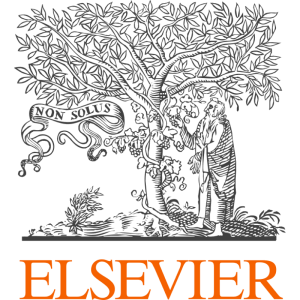




















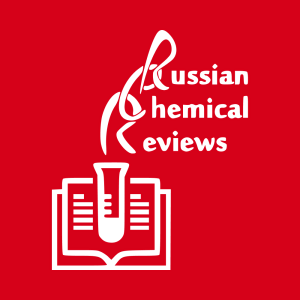



























































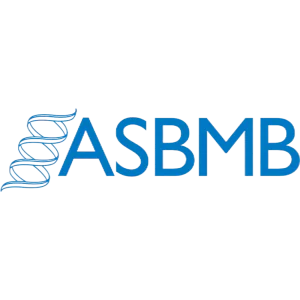















































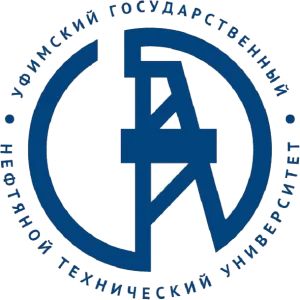































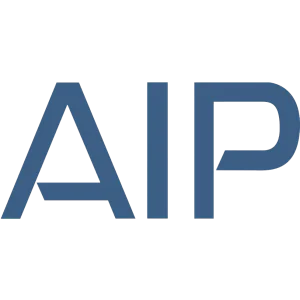



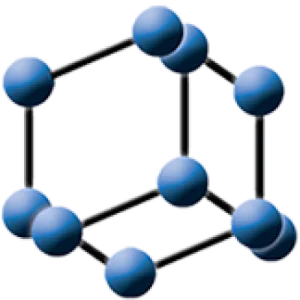





































































![Biodegradation of PCB congeners and their mixtures by aerobic strains in a mineral medium [79, 95, 99, 101, 102, 113, 104-106, 108-110, 117-136]](/storage/images/resized/iMy2B5qCRRkNj1fd4vpp5um2jqcBJcTaUWILKJLL_xl.webp)

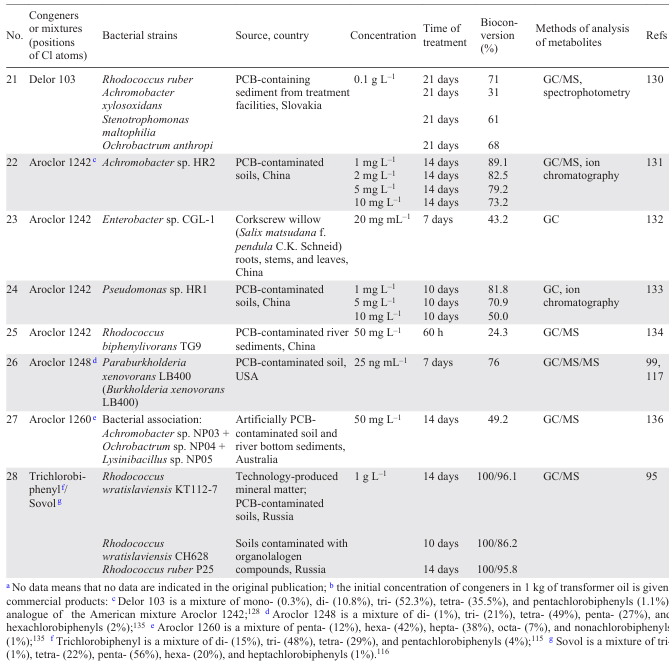
![Products of PCB reactions with KOH in 2-aminoethanol [163, 164]](/storage/images/resized/v5zduNsm2qSEkpJgCZqIYN8tisnudFDYpS6E7wx3_xl.webp)
![Quantitative data on the products of reactions of Sovol and Trichlorobiphenyl mixtures with KOH in 2-aminoethanol (see Scheme 8).[166]](/storage/images/resized/rFbebQvo0jGI34IyDGLuToxk0OFXPVo897ErOMil_xl.webp)
![Biodegradation of PCB-OH derivatives and their mixtures induced by aerobic strains [90, 96, 97, 102, 168-170]](/storage/images/resized/2wLKe36QpoLbwOIEYtQcu4Wn57zCkCSJjKElnGBi_xl.webp)
![Synthesis of model compounds to study the biodegradation of polychlorinated biphenyls by the Ullmann reaction [181, 182, 184-194]](/storage/images/resized/RAWbBkGpPJ5D4DOvSiyNZ6biL0rCuYkgMx5HXEoN_xl.webp)
![Suzuki – Miyaura synthesis of model compounds for the study of biodegradation of polychlorinated biphenyl derivatives [160, 186, 203-247]](/storage/images/resized/g0WgT8CwyZMV9TTQptwRC6oMYAwD9xtasDlFdNyF_xl.webp)

